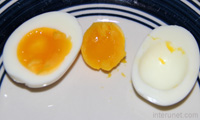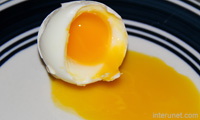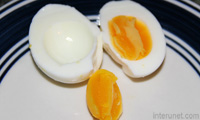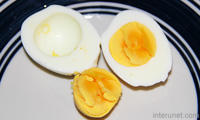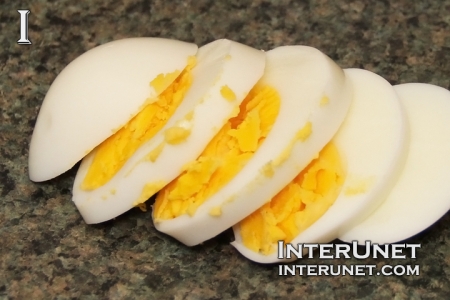
How to know when an egg is boiled enough
How many minutes you need to boil an egg usually depend on the egg readiness you prefer. In other words, whether you desire or need to make soft boiled, medium boiled, or hard boiled egg. That’s why there is no one universal answer to this question. Some people like barely cooked soft boiled eggs where egg whites are pretty much tender, but egg yolks are still as liquid. In contrast, others might consider this type of cooking an egg is dangerous for their health1. On the other hand, for certain recipes you suppose to have well cooked hard boiled eggs. For instance, for egg salad recipes you usually need to make hard boiled eggs where both egg white and yolk are solid. With all that in mind this article will help you to figure out when an egg will be cooked enough in your particular situation.
What effect cooking time of an egg
The cooking time of an egg depends on the size of an egg, temperature of the water when you put the egg into it (cold or boiling), and the egg readiness you prefer. Therefore, it is not ok just to say that you need to cook an egg for 7 minutes, for example, because in your particular situation it may be under or overcooked. Some people consider risky to eat undercooked eggs whereas for others might be even unpleasant to eat overcooked ones. Keep in mind that once an egg reached its hard boiling condition, there usually is no need to boil it further. The egg yolk won't be more solid than it already is. Furthermore, if you way overcook the egg then yolk might lose its appeal. Therefore, even if making an egg seems like very easy and quick process which usually is true, but timing is the key in preparing perfectly boiled eggs.
Egg readiness experiment
For the experiment 10 middle size eggs were boiled for 2, 4, 6, 8, and 10 minutes in order to see after how many minutes the egg whites and yolks become entirely solid. The 10 eggs were divided by two groups. The first set of 5 eggs was put in the cold water where the other set of 5 eggs was put in just started boiling water. In the both examples the time counting was started after the water just began to boil.
Example 1
First set of eggs were put in regular cool tap water. The water with 5 medium size eggs was brought to the boiling condition in 5 minutes 20 seconds and the count of time began. Then gradually every 2 minutes the eggs were taken out from the boiling water and placed in different bowls with regular cold water. When the eggs cooled off, the eggshell was pill off on each egg. After that they were cut by half to see the result after 2, 4, 6, 8, and 10 minutes of boiling in order to compare how they differ from each other.
Example 2
Second set of eggs were carefully put in already boiling water and the count of time begin after that. The boiling period of each egg was remained the same. The 5 medium size eggs were taken out from the boiling water every two minutes and placed in different bowls with cold water. Once they cooled off, the eggshell was pilled off on three last eggs, half on second one, and it was not possible to do it on the very first egg that was boiled just for 2 minutes.
Conclusions
As we can see, the results of boiling eggs directly depend on the water temperature when you put the eggs into. In the first example they look better cooked proportionally to each time frame than in the other example.
- We can clearly notice that where the eggs were put in cold water each eggshell even from the first one was pill off nicely. However, it was hard to do from first two eggs in the second example where those eggs were placed in already boiling water.
- When comparing two pictures under 2 minutes, the egg from the first picture looks perfectly cooked for those who like soft boiled eggs. On the other hand, the egg from the second picture looks barely cooked.
- Both pictures under 4 minutes look way different as well. In the first example the egg is medium cooked as many people would desire if they don’t want to risk themselves with soft-boiled egg and don’t like hard boiled either. However, the second picture under 4 minutes shows us an extra soft boiled egg.
- Frist picture under 6 minutes looks almost like ready hardboiled egg. In contrast, the egg from the second example looks more like the egg from the picture under 2 minutes of the first example.
- Under 8 minutes pictures look like approximately 95% ready and medium boiled egg respectively.
- Under 10 minutes picture of the first example the egg white and yolk is entirely solid, but in the second example it still look like about 80% ready.
Is it safe to eat soft boiled eggs?
It depends mainly on eggs and your health conditions. Any doctor can tell you that not enough cooked eggs might still carry salmonella bacteria. Therefore, eating soft-boiled or raw eggs may not be recommended for some people especially if you are pregnant or breastfeed because of the risk that the eggs may have the bacteria.


